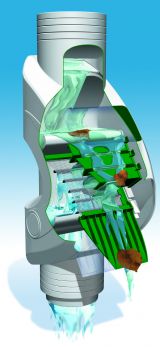The fact is that soft water is readily available wherever you live. We’re talking about water which is actually almost pure already, so running costs become negligible. You can use it with no feelings of guilt whatsoever, even during hosepipe bans since it is totally environmentally friendly and best of all, its free!
Too good to be true? That’s right, we are talking about rainwater. The new buzzword that will be heard over the next few years will be ‘rainwater harvesting’.
In view of the scarcity and precious nature of potable water, rainwater harvesting is becoming increasingly popular for domestic applications. It’s surprising how much water can be collected from a standard roof. A house roof may collect 80,000 litres of rainwater every year.
Downspout filter
With purity of around 4 parts per million, rainwater is ideal for pole based window technology.
To collect the rainwater is a simple task of diverting the downspouts of your guttering to a storage tank. It is essential that the tank does not allow light through to the water to prevent algae growth, so a black container or underground tank works best. To keep the TDS level to a minimum, the roof and guttering should be maintained so as to be free of dirt and sludge.
Rainwater should pass through a filter to strain out larger contaminants like insects and leaves before entering the tank. A submersible pump can be placed inside the tank to pump the water through one or two DI vessels to polish the water. Some window cleaners that collect rainwater use the water without even passing it through a DI vessel since the TDS level is so low anyway. It’s good practice however, to use water at a TDS level of 000 and with such a low TDS level, the resin will last a long time anyway.
Of course, it doesn’t rain everyday so the tank size should be large enough to store water from rainy periods which can be used during drier periods. An underground tank size of 3000 or 4000 litres would be ideal. Another method could be a modular system of smaller water butts connected in series above ground.
We mentioned earlier that a house roof may collect 80,000 litres of rainwater each year. This is based on the total surface area of a typical 3 bedroom semi detached house. Obviously, the larger the surface area of the roof or collection surface, the more rainwater collected. For every inch of rainwater water that falls on a surface of 1000 square feet it is possible to collect approximately 600 gallons of water.
80,000 litres of rainwater per year would be sufficient to fill a 300 litre tank each working day of the year. This could dramatically reduce water bills and with the much publicised, continual water rate increases, we cannot afford not to save our water and subsequently save money and the environment.
Being green is also a good selling point. Nowadays customers appreciate a company that is responsible towards the environment. Even if window cleaners were to be given exemption, customers are not always comfortable about having their windows cleaned with a water fed pole system during a hosepipe ban. Explaining that you use harvested rainwater would no doubt resolve the problem.
There’s no doubt about it, whatever your water usage may be, the investment of setting up a rainwater harvesting system would soon pay itself off. Interestingly, Enhanced Capital Allowances (ECAs) enable a business to claim 100% for rainwater harvesting equipment.
For more info visit: http://www.ukrha.org/index.php
